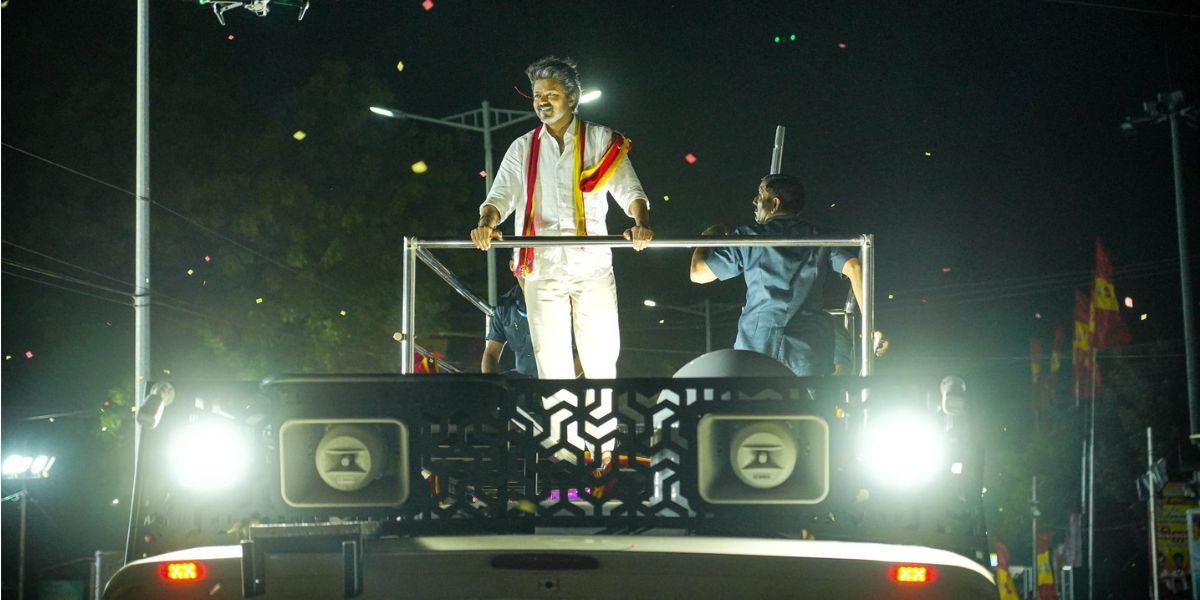Unlike others, Vijay waited nearly a month after the stampede before meeting the families — and chose to do so in Mahabalipuram, not Karur.
Published Oct 27, 2025 | 3:10 PM ⚊ Updated Oct 27, 2025 | 3:10 PM

Vijay during the political rally in Karur.
Synopsis: TVK chief Vijay met the families of the people who lost their lives during a stampede during his political rally in Karur in September. However, the venue of the meeting — a five-star hotel in Mahabalipuram — has sparked debates.
Exactly a month after the tragic stampede that killed 41 in Karur of Tamil Nadu during a political rally of Tamilaga Vettri Kazhagam (TVK) chief Vijay, the actor-turned-politician, on Monday, 27 October, met the bereaved families — not in Karur, but at a star hotel in Mahabalipuram, near Chennai.
While the meeting was meant to offer comfort and solidarity, the venue choice sparked debate in Tamil Nadu’s political circles.
TVK sources said they could not find a suitable venue in Karur and that a return visit might have triggered logistical and crowd-control challenges. Yet, critics argue that bringing grieving families hundreds of kilometres away to meet him appears insensitive and politically calculated.
While Tamil Nadu is no stranger to such tragedies, the response of leaders during those times provides a striking contrast to Vijay’s decision. In the past five decades, at least three major stampedes have claimed over forty lives each.
The Mahamaham festival in Kumbakonam — held once every twelve years at the Adi Kumbeswarar temple — turned deadly on 18 February 1992, when over 48 devotees died in a stampede.
J Jayalalithaa, who was then the chief minister, attended the ritual bathing ceremony earlier that morning and left the venue soon after completing her holy dip. Later, when thousands of devotees surged toward the sacred tank, a crowd crush occurred.
Though Jayalalithaa’s early departure drew some criticism, the government denied any link between her visit and the tragedy. Families of the deceased were given ₹50,000 each as compensation, but Jayalalithaa did not personally visit the victims’ families.
However, other political leaders visited the affected families in person.
On 7 June 1997, a temple festival at the Brihadeeswarar Temple in Thanjavur turned tragic when a fire and ensuing stampede killed over 40 people, many of them women and children.
The then-chief minister, M Karunanidhi, visited the site the next day and met the victims’ families.
He announced ₹1 lakh compensation for the deceased and ₹50,000 to ₹1 lakh for the injured, depending on the severity of injuries.
Several ministers stayed on-site overnight to coordinate relief measures.
In 2005, weeks after the devastating tsunami hit Tamil Nadu’s coast, relief aid was being distributed in Chennai’s MGR Nagar area, part of KK Nagar.
As thousands gathered at a local school to collect relief money and rations, a stampede erupted, killing 42 people, including women and elderly residents.
Even though the then-chief minister Jayalalithaa did not visit MGR Nagar, she visited the Royapettah Government Hospital to meet the injured. The government announced ₹1 lakh for each victim and ₹15,000 for the injured.
However, MK Stalin visited each affected street and met the families of the deceased.
Since then, Tamil Nadu has witnessed other crowd-related fatalities, including the 2019 Athi Varadar festival in Kanchipuram and the 2024 Indian Air Force air show in Chennai, where five people were killed.
However, the Karur stampede on 27 September 2025 stands out as one of the worst crowd tragedies in the state’s political history.
Soon after the news about the tragedy broke, Chief Minister Stalin left for Karur and reached there the same night. He met the families of the deceased and announced ₹10 lakh for each victim, along with ₹1 lakh for the injured.
Leader of Opposition in Tamil Nadu Assembly Edappadi K Palaniswami and several other party heads also visited Karur to console victims.
Vijay, in contrast, waited nearly a month before meeting the families — and chose to do so in Mahabalipuram, not Karur. This decision has triggered sharp political commentary about his leadership style and image management.
However, he had given an ex-gratia financial aid of ₹20 lakh to the families affected by the stampede.
Every political leader has their own style of responding to crises. In Jayalalithaa’s case, she often chose not to visit disaster sites directly after large-scale tragedies. Instead, she would meet victims or the injured in controlled environments such as hospitals or extend condolences through official channels.
Jayalalithaa’s stature as an actor-turned-political icon, admired for her charisma and distance from the crowd, shaped her political persona.
Vijay, similarly, remains a celebrity figure first, whose entry into politics is closely watched for echoes of MGR and Jayalalithaa’s styles — both cinematic and carefully orchestrated.
While Karunanidhi had built his political identity purely through ideology and grassroots presence, Vijay’s leadership, much similar to Jayalalithaa’s, continues to be defined by his star power and symbolism.
Now, by avoiding Karur and meeting victims at his chosen location, Vijay has revived the question: “Is he consciously following Jayalalithaa’s political playbook — balancing distance, discipline and dramatisation?”
For several people in Tamil Nadu’s political world, the answer may depend on what Vijay does next — whether he continues to script his politics like his films, or steps fully into the unpredictable theatre of real-world leadership.
(Edited by Muhammed Fazil.)
